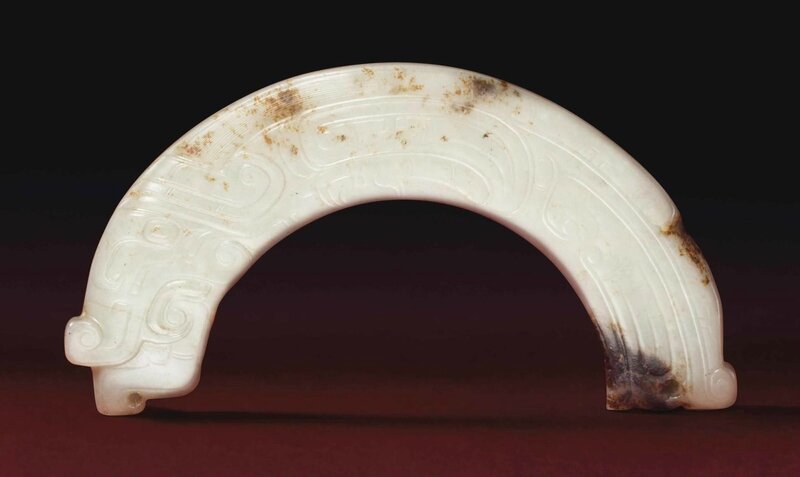An exceptionally rare pale grey jade huang, Western Zhou dynasty, 9th-8th century BC
Lot 910, An exceptionally rare pale grey jade huang, Western Zhou dynasty, 9th-8th century BC. Estimate USD 60,000 ~ 80,000. Photo Christie's Image Ltd 2016.
The thick pendant is well carved as a composite animal, with the head of a horned dragon, its long mane finely incised with hair markings below the upper edge above the wings and talons of a bird. It is pierced for suspension at each end with a small bi-conical hole. The stone is semi-translucent and of pale grey color with some dark brown markings or areas of alteration. 4 in. (10.2 cm.) long, box
Provenance: Sotheby's London, 13 June 1989, lot 40.
Literature: Magic, Art and Order: Jade in Chinese Culture, Palm Springs Desert Museum, 1990, p. 67, no. 59.
Nicole De Bisscop, Chinese Jade and Scroll Painting from the Dongxi Collection, Brussels, 1995, p. 45, no. 14.
Filippo Salviati, "The Dongxi Collection of Chinese Jades", Orientations, November 1995, p. 47, fig. 4.
Exhibited: Magic, Art and Order: Jade in Chinese Culture, Palm Springs Desert Museum, California, no. 59.
Chinese Jade and Scroll Paintings from the Dongxi Collection, Kredietbank Gallery, Brussels, 25 October - 17 December 1995; Kredietbank Luxembourg, 1 February - 13 April 1996, no. 14.
Notes: The present huang is characterized by the exceptional artistic and technical quality of the carving as well as the unusual and very rare composition of the decoration. Huang were a component of burial pectorals or necklaces which were composed of a varying number of pendants hung on strands of beads. A reconstruction of one of these late Western Zhou period pectorals comprised of many huang of various types excavated from Tomb M 63, Fianma-Wucun (Beizhao Quwo), Shanxi province, is illustrated by Xiaoneng Yang (ed.), in the exhibition catalogue, The Golden Age of Chinese Archaeology, National Gallery of Art, Washington DC, 1999, no. 86. A smaller pectoral which includes three huang is illustrated p. 253, no. 85.
This well-carved huang is similar to one excavated in 1986 from Western Zhou tomb no. 273 at Zhangjiapo, Chang'an Xian, Shaanxi province, and illustrated in Zhongguo Yuqi Quanji - 2 - Shang/Western Zhou, Hebei, 1994, p. 208, no. 290. Like the present example, this huang has a dragon head at one end and a taloned foot below a wing at mid-body, while the remainder of the decoration dissolves into abstract patterns. This representation of a single dragon on ahuang has its antecedents in Shang dynasty huang, such as the example from the tomb of Lady Fu Hao, illustrated inThe Jades from Yinxu, Beijing, 1982, pl. 41 (upper right), and another in the Museum of Far Eastern Antiquities, Stockholm, illustrated by W. Watson in The Arts of China to AD 900, New Haven/London, 1995, p. 54, pl. 101, where it is dated 10th-9th century BC. Other Western Zhou huang of this type more usually have a symmetrical design with either dragon or human heads at each end, and shared or entwined decoration in between. Two such examples are illustrated in Zhongguo Yuqi Quanji - 2 - Shang/Western Zhou, ibid., p. 209, nos. 291 and 292. Another of this latter type that has a dragon head with similar rolled snout and open jaws at each end is illustrated by J. F. So in Chinese Jades from the Cissy and Robert Tang Collection, Art Museum, The Chinese University of Hong Kong, 2015, p. 85, no. 12e. The style of carving is similar and also incorporates a taloned foot as well as what appear to be sections of hair beside each head.
Christie's. DONGXI STUDIO- IMPORTANT CHINESE JADE AND HARDSTONE CARVINGS FROM A DISTINGUISHED PRIVATE COLLECTION, 17 March 2016, New York, Rockefeller Plaza

/https%3A%2F%2Fprofilepics.canalblog.com%2Fprofilepics%2F1%2F0%2F100183.jpg)
/https%3A%2F%2Fstorage.canalblog.com%2F03%2F02%2F119589%2F96711876_o.jpg)
/https%3A%2F%2Fstorage.canalblog.com%2F11%2F31%2F119589%2F94773502_o.jpg)
/https%3A%2F%2Fstorage.canalblog.com%2F20%2F83%2F119589%2F94772815_o.jpg)
/https%3A%2F%2Fstorage.canalblog.com%2F26%2F72%2F119589%2F75604929_o.jpg)
/https%3A%2F%2Fstorage.canalblog.com%2F59%2F60%2F119589%2F26458628_o.jpg)



/image%2F1371349%2F20240421%2Fob_f95a94_438845907-1654643788638967-91458904872.jpg)
/http%3A%2F%2Fstorage.canalblog.com%2F80%2F10%2F119589%2F129845673_o.jpg)
/http%3A%2F%2Fstorage.canalblog.com%2F45%2F96%2F119589%2F127991050_o.jpg)
/http%3A%2F%2Fstorage.canalblog.com%2F33%2F28%2F119589%2F127973647_o.jpg)